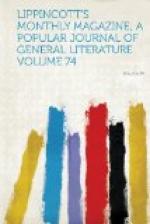Wherever Mr. Mickley journeyed, so long as any fresh acquisition of knowledge was to be gained the old traveller appeared insensible to fatigue. When halfway up the Great Pyramid an English group who were in his company stopped and insisted upon going no farther. He resolutely continued, and they, unwilling to see so aged a man out-distance them, followed reluctantly, until all reached the summit and congratulated each other on the famous view. In St. Petersburg, Moscow, and other Russian cities, which he visited in the winter season, he was equally untiring and undaunted. As a specimen of his accuracy of observation, he writes during his first journey in Italy, “I counted forty-six tunnels between Pisa and Bologna.” Several severe accidents fell to his lot. In Rome, while exploring a dark, arched passage, he fell into “Cicero’s Well,” receiving severe bruises. In a street in Constantinople, where there are no sidewalks, he was knocked down by a runaway horse and taken up for dead, remaining insensible for several hours. The former of these mishaps occupies three lines in his diary; the latter, twelve lines. On his third visit to Leipsic he was confined in his room for several weeks with an attack of smallpox. But in regard to none of these accidents, although an aged man, thousands of miles from home, and entirely alone, does he betray any symptoms of apprehension. He merely adds, on the date of his recovery from the attack at Leipsic, “This sickness has detained me much longer than I had expected to stay.”
In one of Mickley’s trips he made a not unimportant contribution to musical history. Almost every student of instrumental music is acquainted with the name of Jacob Steiner or Stainer, the most successful of violin-makers outside of the Cremonese school of workmen. Of Steiner’s life but little is known, and no biography of him extant in either French, German, or English contains either the date or place of his death. The account commonly given is that he separated from his wife and died in a convent. Mr. Mickley, with his accustomed perseverance, started out to see if this matter might not be cleared up. At Innspruck he inquired in vain for information. As Fetis and Forster both fixed his birthplace at Absom, a small village some twelve miles from Innspruck, Mickley repaired thither. For some time his errand was fruitless. He stopped in at a little shop where an old woman sold photographs, etc. “I asked her, ’Did you never hear of Jacob Steiner, the violin-maker?’ She replied, ’There is no Steiner nor violin-maker living in this town.’ I then said that a celebrated violin-maker of that name, of whom I desired some information, had lived there two hundred years before. She replied, quite seriously, ’I am not two hundred years old.’” A few minutes later, in the course of his walk, his eye fell upon an old church, the outer wall of which contained a number of stone tablets with inscriptions. A search of five minutes revealed the desired information. On a plain tablet Steiner’s name was found, together with the information, given in very old-fashioned German, that he had died there in 1683, “at the rising of the sun.”




